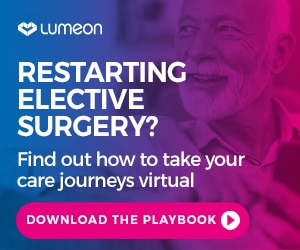By Robbie Hughes, Lumeon CEO
First published in Fierce Healthcare 06.15.2020.
State by state, health systems are threading the needle in balancing their own health economics and public health concerns.
With a huge backlog of pent up demand, we might expect (socially distant) queues round the block for every aspect of care that has been postponed in the last three months. Except, the situation is more complicated than that. Emergency room visits are down (there are fewer emergencies when people stay at home) and with three months of government-prescribed bed rest, much other ‘normal’ demand has evaporated too.
Demand in healthcare is driven by a ‘need for intervention’ and a ‘desire to take action’. The ‘need’ may still be there, but is the ‘desire’? A straw poll among our customers showed that nearly all are seeing the same phenomenon: patients are scared to go into hospitals.
This is a problem, particularly when profitability for the average health system relies on carrying out actual interventions on patients. So, what can be done to remedy this situation?
We’re seeing health systems advertising that they’re open and can perform virtual visits, but this isn’t enough. After being scared into staying home, getting patients into high-risk locations like a hospital is going to take more than just an email or an updated web page.
The answer is going to comprise some key parts:
1. Prioritization
Hospital resources have been limited by COVID restrictions and need to be prioritized, so understanding who should come first is key. Can providers identify which patients are likely to cancel their interventions due to anxiety? Or which patients might require additional reassurance? Focusing on the obtainable market – not just the addressable market – will be important.
2. Individualized engagement
Every patient is different. The unique combination of their clinical situation, financial situation, and emotional state should determine how healthcare providers engage. For some patients, an email could be all it takes, but for many others, it will take more – perhaps much more. How providers personalize engagements to individual needs will be critical.
3. Individualized journeys
Once the patient is engaged, providers must ensure that their prescribed intervention is appropriate. Does the patient have underlying conditions that increase their risk? Do they need to come in for testing, or can providers rely on previous results? Can tests be completed outside the hospital? Providers must continually ask themselves: are we doing everything we can to reduce exposure for that individual?
4. Combining virtual with physical
Providers should also determine when virtual visits are appropriate. Can this patient be seen remotely only, or will they need a blend of physical and virtual? How much of their care can be virtualized before they need to visit the hospital? If they’re coming in for intervention, is it possible to reorganize care delivery to do everything in that one session?
The solution lies in orchestration
These issues show that we have more to worry about than just scheduling a backlog of activity with reduced capacity. We have a problem that requires a sensitive application of clinical and operational best practice, on an individualized basis, to a disengaged population that questions their safety in a hospital setting.
This is ultimately an orchestration problem – how we ensure that patients and care teams are guided to do the right things on a case by case basis. Without advanced orchestration capabilities, we will be forced to apply ‘worst case’ measures to every patient. This won’t be sustainable.
Interestingly, we have seen this exact problem manifest even before the pandemic in outpatient surgery. One of our customers had a surgical optimization unit that delivered great outcomes, but they couldn’t scale it to meet demand in an affordable way.
Within the first three months of deploying our solution, 89% of preoperative patient visits were conducted virtually, rather than face to face as they had been previously. We also reduced late delays and cancellations, while substantially increasing clinical team ‘joy at work’.
What’s interesting about the 89% figure is that this was an average; it fluctuated dramatically day-to-day, depending on the case-mix. In the first week, the figure was 98% as it was only activated for lower-risk patients. This is the key to orchestration – a system responding dynamically to the inputs presented – and will be the foundation of what is needed moving forward. To learn more about our approach and how it can be applied to COVID-19, we’ve created a Virtual Care Playbook for Surgery
The old tactics of the handsome physician on a billboard and a gold star rating isn’t going to cut it anymore when it comes to getting patients through the door. Patients are scared and unless they get assurances that their individual needs are going to be met with best practice applied, they won’t come in, and that revenue ‘bump’ that hospitals are anticipating isn’t going to materialize.


